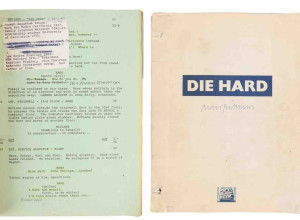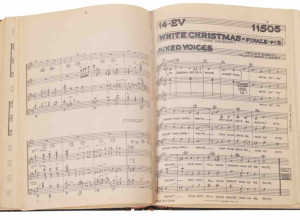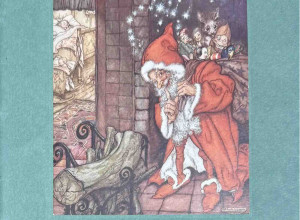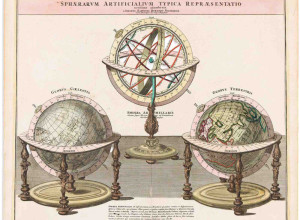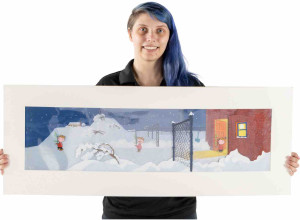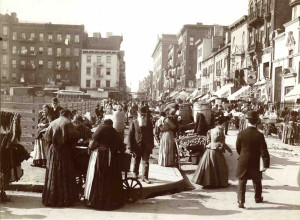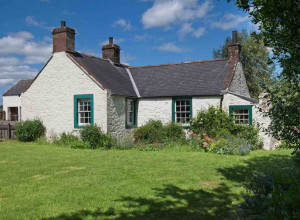John Lennon’s Original Drawings, Poems, and Prose to be Offered at Sotheby’s
Sotheby’s is delighted to announce the auction of this important collection of John Lennon autograph drawings and manuscripts produced by the artist for his critically acclaimed books: In His Own Write (1964) and A Spaniard in the Works (1965). Including 89 lots ranging from $500 to $70,000, this is the largest private collection of John Lennon’s work ever to come to market. The sale coincides with two important landmarks for Lennon: the 50th anniversary of the publication of In His Own Write; and the 50th anniversary of The Beatles’ landmark first appearance in America on the Ed Sullivan show, which launched them into the pop stratosphere.
These remarkable drawings and manuscripts come from the collection of legendary publisher Tom Maschler, who as Literary Director of Jonathan Cape in the 1960s, was responsible for bringing both In His Own Write and A Spaniard in the Works to fruition. This phenomenal collection of works from Lennon’s own hand, often complete with deletions and amendments, represents the raw material from which Tom Maschler honed the two critically-acclaimed Lennon books. Given to Maschler by the artist himself, this material has been treasured by Lennon’s publisher for the last 50 years.

Tom Maschler recalls: “My relationship with John Lennon was different to those I had with all the other authors I worked with over my years as a publisher. Having seen a superb sketch of his that a mutual acquaintance showed me, I met with John to suggest that he should produce John Lennon In His Own Write. I then had to inspire in him the confidence to write and produce the drawings.”
Including nonsense verse, puns, wicked humour and comic drawings, these books underline Lennon’s accomplishments as both an artist and an author-revealing an alternative perspective on one of the twentieth century’s greatest musicians.
Commenting on John Lennon’s artistic talent, Maschler continues: “I knew that he had the most extraordinary talent and imagination—in addition to his many other gifts that had made him world famous—though I feared that being A Beatle might result in his not being taken seriously as a writer and artist. I was wrong. For his writing was even compared to Hilaire Belloc and Edward Lear by serious critics. His art, however, was underrated then, and I believe it remains so. I very much hope that this auction will redress the balance.”
John Lennon’s development as a literary and artistic phenomenon
John Lennon was a keen writer from his schooldays onwards, and following the publication of his first book he recalled that “I started all this writing long before I was a pop artist, or even a Beatle, or before I had a guitar...The guitars came second.” As a child, he spent his time writing and illustrating his comic The Daily Howl rather than paying attention to his lessons. Following school he trained as an artist at Liverpool School of Art.
In 1962 an author whom Tom Maschler was working with came to see him and handed Maschler some drawings and writings-many scrawled on the back of hotel notepaper. Maschler found them extraordinary and immediately identified the great talent behind them: “Who wrote these?” “John Lennon,” came the reply. “You’re kidding,” I said, and then I asked: “When can I get to see him?” Soon after, Maschler attended a Beatles’ show and was taken back stage to meet John: “The Beatles stood side by side behind a heavy iron grille. The fans slid programmes underneath the grille for the Boys to sign. The mix was approximately four girls to one boy, and as the girls passed by many of them keeled over. There were nurses in attendance and they steered the fans to a row of waiting ambulances. All this must have gone on for the best part of an hour. I sat in fascination. Finally I was introduced to John as ‘that fellow, the publisher’.”
Speaking about the first occasion on which he met Lennon to start work on the first of his books, Maschler recalls: “And there he was, at his flat at 13 Emperor’s Gate, SW7, together with Paul, Ringo and George. Outside the main door there were a hundred kids clamouring to get in. The Beatles behaved as though they were in a zoo and so John and I had to creep into a corner to do our work. John was surprisingly willing to listen to my editorial suggestions. He loved praise, as do we all, and of course he did not like criticism.”
Speaking about the process of creating the drawings for In His Own Write, and the editorial experience of working with Maschler, John Lennon commented in a BBC radio interview a week before the book’s publication: “They are spontaneous, and I hardly ever alter anything because I’m selfish about what I write or big-headed about it. Once I’ve written it, I like it. And the publisher sometimes says, you know, ‘Should we leave this out, or change that?’ and I fight like mad ‘cuz once I’ve done it I like to keep it. I might add things when I go over it before it’s published, but I seldom take anything out. So it is spontaneous . . .” The publication of In His Own Write prompted effusive reviews from the high-brow press who drew comparisons with the works of Edward Lear and Lewis Carroll. The Times Literary Supplement wrote that the book ‘is worth the attention of anyone who fears for the impoverishment of the English language and the British imagination.’
According to Yoko Ono, it was Lennon’s drawings in both his books which first attracted her to him, before the two had even met. “They showed me John’s soul,” she would later write. “A witty, funny and relentlessly romantic spirit with a taste for the grotesque.”
One of the most exacting definitions of Lennon’s artistic style given in recent years is that of Professor Wulf Herzogenrath: “John Lennon’s drawings are creative masterpieces situated between free drawing, caricature and illustration. Even today, they still bear witness to the keen sense of observation, wit and profound irony with which Lennon saw the world around him. In his works he is always interested in people, and even if they sometimes got on his nerves, certain characters, scenes or chance occurrences touch him. His works are precise observations, often based on his own sentiments. . . He draws with simple stroke and clear line, often concluding with a single confident flourish . . . “
World Renowned Literary Publisher Tom Maschler
Tom Maschler was for many years the Literary Director of renowned imprint Cape, and is recognised internationally as a leading light amongst the legendary names in post-war publishing—an inspirational figure who, at the end of the millennium, was identified as one of the ten people who most influenced publishing in the Twentieth Century. Doris Lessing descri bed his ‘high-octane energy, which, combined with his passion,made him a most formidable, persuasive and dynamic force.
Maschler is most celebrated of all for creating The Booker Prize which he masterminded from the very beginning. Within a few years it had become by far the most influential fiction prize in the world. He nurtured the careers of many of the luminaries of Twentieth Century literature on both sides of the Atlantic, his earliest coup being the purchase of Joseph Heller’s Catch-22 in 1961. Others include: Tom Wolfe, Edward Albee, William Styron, Thomas Pynchon, Kurt Vonnegut, Philip Roth and Salman Rushdie.
Maschler has also published as many as fifteen Nobel Prize-winning authors, names such as Gabriel Garcia Marquez, Patrick White, Isaac Bashevis Singer, Pablo Neruda, Giorgos Seferis, Mario Vargas Llosa, Derek Walcott and Doris Lessing. In children’s fiction, his pairing of Roald Dahl and Quentin Blake is just one of the many notable historic literary landmarks for which Maschler is responsible.
Speaking about his relationship with John Lennon, Maschler said: “John was an exceptional friend and a most unusual human being. He had the most original sense of humor and he could also be extremely funny. Revisiting the creative process that led to these remarkable books, and my relationship with him throughout and beyond, has made me realise the more just how much I miss him.”
A Snapshot of the Sale
- “Liddypool”—A typescript amended by Lennon himself providing a satirical guide to Liverpool, the city of Lennon’s birth, including a host of local references to historical monuments, the airport, local clubs and coffee bars est. $12,000-15,000
- “Sad Michael”—A typescript amended by Lennon himself that includes the first appearance in print of the phrase ‘a hard days night’ est. $5,000-7,000
- One lot comprising a group of early typescripts including fascinating unpublished material. One piece refers to The Beatles’ first recording session at Abbey Road studios and announces the band’s first single ‘Love Me Do’ est. $15,000-20,000
- “The Singularge Experience of Miss Anne Duffield”—A nine page manuscript in Lennon’s hand of this bizarre and hilarious parody of Sherlock Holmes est. $50,000-70,000
- "The Fat Budgie”—The original autograph manuscript of one of Lennon’s best-loved nonsense poems est. $25,000-35,000
- An untitled illustration of a boy with six birds published in Lennon’s second book was reused 30 years later as the cover for the Beatles’ release Free as a Bird. Written by Lennon in 1977, the song was released with contributions from Paul, George and Ringo 25 years after the band’s break up and 15 years after Lennon’s death est. $12,000-15,000
John Lennon ‘You Might As Well Arsk’
Sotheby’s New York, 4th June 2014
Exhibition Dates
Sotheby’s London, 34-35 New Bond Street, 21-25 March 2014
Sotheby’s New York, 28th May- 3rd June





